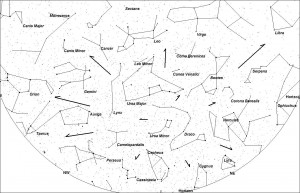The next major shower will be the Quadrantids, which are predicted to peak near 07:30 Universal Time on January 4, 2012.

This illustration depicts Quadrantid meteors as seen from near 40 degrees north latitude during the last hour before the start of morning twilight on January 4, 2012.
This timing favors North America with local peak times ranging from 02:30am EST on January 4th to 11:30 PST on January 3rd. The eastern half of North America will be more favorable as the radiant will lie higher in the sky at the time of maximum activity.
The Quadrantids are active from January 1st through the 10th but a great majority of their activity is produced during a six hour window on the morning of maximum activity. The radiant for the Quadrantids is located at 15:18 +50. This portion of the sky is located in a sparse area of northern Bootes between the stars Iota Draconis and Beta Bootis. The radiant is circumpolar for locations north of latitude 50N and briefly sets below the northern horizon for locations further south in mid-northern latitudes. The radiant is best placed during the last dark hour before dawn when it lies highest above the horizon in a dark sky. Far northern locations have a small window of opportunity to see Quadrantids just as evening twilight ends. The radiant will then be located low in the northwestern sky. Unfortunately the waxing gibbous moon will interfere this year with any attempts to view activity during the evening hours. The radiant reaches its lowest point near 1900 local standard time and then begins its slow ascent into the northeastern sky as the night progresses.
On the morning of January 4th, the 77% illuminated moon will set between 02:00 and 03:00, depending on your latitude. This coincides with the predicted time of maximum activity in the Eastern Time zone. The moon will be above the horizon for other time zones to the west. Still, the low altitude of the moon and the fact that it lies in the opposite portion of the sky will allow good views of any Quadrantid activity. If the moon is above your horizon be certain to view with it to your back to allow you to face the darkest sky possible.
Maximum rates for this shower are difficult to predict. Most observers across North America can expect to see a maximum of 40 Quadrantids per hour on the morning of January 4th. If you are lucky it could be several times higher.
A good observing strategy for observers in North America would be to begin observations near midnight. This will allow eastern observers to catch the maximum should it arrive a bit early. Pacific observers may want to start around 2300 (11pm) on the 3rd. While rates would most likely be low for western observers, any Quadrantid activity would be in the form of earthgrazing meteors, which are long-lasting as produce long trails as they graze the upper atmosphere. Face anywhere in the north to east quadrant, with your field of view half way up in the sky. This will keep the moon at your back. Quadrantid meteors will shoot upward from the northeastern horizon until it gains sufficient when it can produce meteor shooting in all directions.
Observers located in the northern hemisphere other than North American can expect to see approximately 25 Quadrantids per hour between moon set and dawn. Due to the high northern declination (celestial latitude) of the Quadrantid radiant, observers in the southern hemisphere will see very few Quadrantids. As seen from the southern hemisphere the Quadrantid radiant lies low in the north, if it clears the horizon at all before dawn.
This shower is named for the obsolete constellation Quadrans Muralis (Murals Quadrant), which once occupied the area of northern Bootes. Some meteor organizations refer to this shower as the Bootids. It is thought that this shower is related to the recently discovered asteroid 2003 EH1. Peter Jenniskens, who discovered this relationship, states that this object is most likely an extinct comet nucleus that appears to be the remnant of a larger object that broke up about 500 years ago. The Earth intersects the orbit of this object near January 3rd each year. The Earth intersects this orbit at a perpendicular angle, which means we quickly move through any debris produced by this object.
Don’t waste this opportunity to view this elusive shower. The Quadrantids of 2013 will peak with a last quarter moon in the sky. Maximum activity will also occur after daybreak for most of North American so should your skies be clear, do not waste this opportunity to view this shower.




